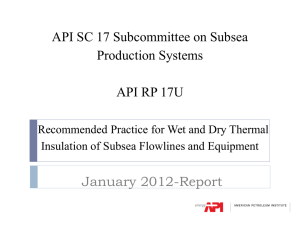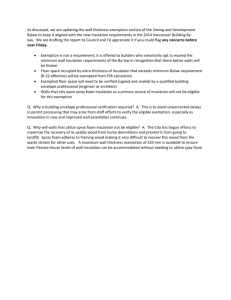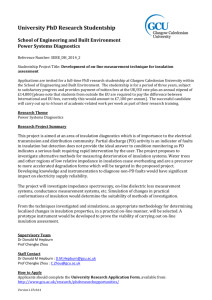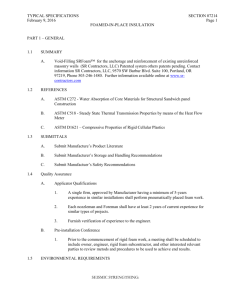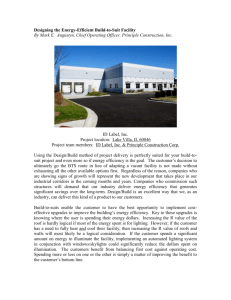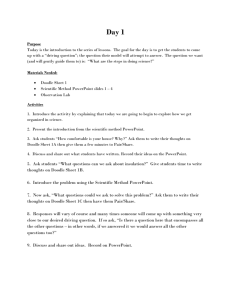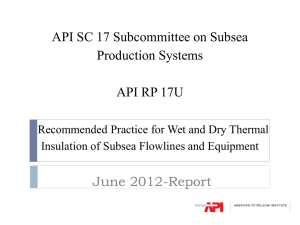Sound insulation
advertisement
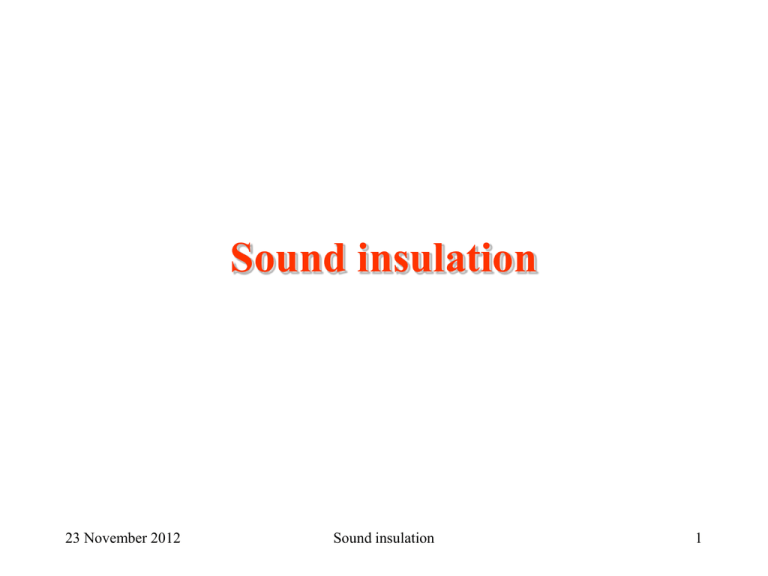
Sound insulation 23 November 2012 Sound insulation 1 Sound against a wall • Balance of sound energy impinging over a wall • The energy balance shows three main fluxes: – Reflected – Absorbed – Transmitted • Hence three coefficients are defined, as the ratios with the impinging energy 23 November 2012 16 Sound SoundAbsorption insulation r+a+t =1 2 Materials: sound insulating & sound absorbing Sound absorbing materials must not be confused with sound insulating materials: Sound Insulating material: Heavy and stiff, minimizes transmitted power “Wt”. the Sound Absorbing material: Soft and porous, minimizes reflected power “Wr”. 23 November 2012 16 the Sound SoundAbsorption insulation 3 The Sound Reduction Index R With regard to a sound imping over a wall we define t as: • transmission coefficient: Wt t Wo It is the ratio between the transmitted power Wt and the incident power Wo. The Sound Reduction Index R of a wall characterized by a transmission coefficient t is given by: • Sound Reduction Index: (dB) 23 November 2012 Sound insulation 1 R 10log10 t 4 Change of R with frequency 4 different frequency ranges can be identified: • Rigidity region, 6 dB/octave. R drops by • Resonance region (the whole panel is affected by resonances and antiresonances). • Mass region, 6 dB/octave. R increses by • Coincidence region (coincidence between wavelength in air and inside the flexural vibrations of the panel make the Sound Reduction Index to drop). 23 November 2012 Sound insulation 5 The mass law R = 20 × lg (s × f ) - 42.5 (theoretical) R = 20 × lg (s × f ) - 44.0 (practical) • The value of R increses by 6 dB when doubling the frequency. • The value of R increases by 6 dB when doubling the mass of the wall Single Wall Double Wall Two separate walls R = 30 dB R = 36 dB R = 60 dB 23 November 2012 Sound insulation 6 Coincidence frequency • Example: steel, Fcr=97700 Hzm2/kg, = 8.1 kg/(m2mm) • s = 10mm, hence = s = 8.110 = 81 kg/m2 • fcoinc = Fcr/ = 97700/81 = 1206 Hz 23 November 2012 Sound insulation 7 Sound Insulation D vs Sound Reduction Index R • • The Sound Reduction Index R is defined by: 1 R = 10× log t The Sound Insulation D is defined by: D = L1 - L2 • We can make an energy balance of the energy passing through the separating wall, having surface Sdiv, and reverberating in room 2, having an equivalent absorption area A2: I1 × S × t = I 2 × A2 • After some math passages, we get the relationship between R and D: 23 November 2012 Sound insulation Sdiv R = L1 - L2 +10 × log A2 Sdiv R = D +10 × log A2 8 Apparent Sound Reduction Index R’ • Theory – definition of t and R • Practice – lab measurement (R) no flanking transmission R ³ R' ( R - R') @ 3¸ 5 dB • Practice – in situ measurement (R’) significant flanking transmission 23 November 2012 Sound insulation 9 Weighted Sound Reduction Index RW • A reference curve is shifted down at 1 dB steps, until the sum of unfavourable deviations becomes smaller than 32 dB • At this point, the weighted value of the Sound Insulation Index, Rw, is read on the reference curve at the frequency of 500 Hz. 23 November 2012 Sound insulation 10


